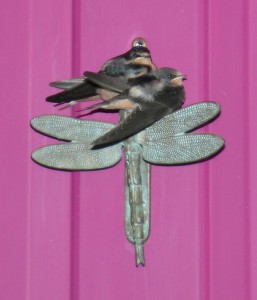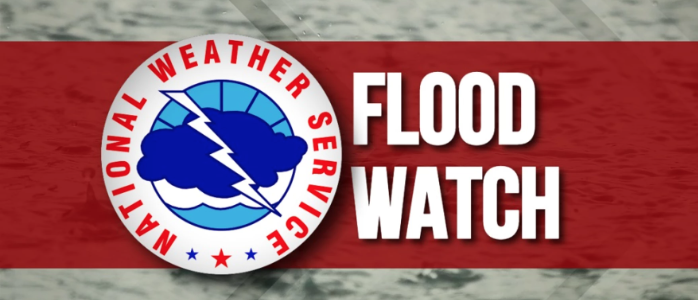by Janice Richardson

A pair of swallows light on the Dragonfly Gardens door knob.
Observing the web of life and the intricacies of nature has become a passion of mine. I’m particularly moved by the phenology or timing of things. The notes on my calendar track the patterns that cycle through each year.
With the advent of the winter solstice and the increase in daylight there is a quickening of the life force that energizes nature. I imagine that even seeds can feel it. The potatoes in my cupboard start sending their shoots on a mission to find the light. Every time I open the cupboard they call to me to plant them and my green thumb starts to itch. This happens at about the same time every year and lets me know the gardening season will soon be here.
Mid-winter in early February marks the return of the first songbird scouts to the forest around my house. They sing their solos on those beautiful crisp blue-sky mornings that makes a person want to open up the house and do a spring cleaning. These songbird melodies are nature’s yearly wake up call to come out of hibernation.
The scouts stay for a few days, see if the habitat is still intact, and depart to tell the others that it is safe to come. In a few weeks, more will return and begin nesting. Each day I look and listen for the new arrivals. The winter wren and purple finch are early arrivals. Soon the flocks of robins and sparrows join the chatter of juncos, towhees, nuthatches and flickers who are our year-round residents. The earth thaws and bugs and insects begin to hatch. The food chain comes to life and more wildlife arrives. Hawks and eagles, migrating flocks of geese, all coming as if invited to feast at nature’s great banquet.
Pussy willows are another first sign that nature is waking up. There are some beautiful big trees scattered around the island that always catch my eye. I know it won’t be long before the heather blooms by the house and its scent will attract the friendly “heather bees” who will live there for the next few months. Then the Red-flowering Currant will bloom and the hummingbirds will be back. Daffodils will come up and white plums blossoms will dot the green forest landscape. Each new event is another relationship that adds complexity to the community of living things growing all around me. How truly amazing!
I imagine the earth’s axis tilting toward the sun, thawing the frozen waters of the northern hemisphere. Warmth from the sun sets off a chain of events that leads to the unpredictable weather patterns of our temperate maritime climate. The mixture of sunny and cold wet days is unsettling, but it is the energy that causes spring to “burst forth”. The word spring or “spreng” is about two thousand years old and is found in many Germanic languages. It appears as “spring” in Old English a thousand years later. Reference to spring as the season after winter is more recent and is found in writings as the “springing time” (1387) and the “spring of the leaf” (1538).
There are several perspectives in determining the beginning of spring. Some cultures base it on the phenology in their locale. Most people consider the vernal (Latin for bloom) equinox (equal night) as the official beginning of spring. At this time the sun is directly over the equator and there is an equal (approximately) length of daylight and night. According to the 2009 astronomical calender, this will occur on March 20 at 04:47 PDT.
Celebrating spring on the vernal equinox is a historical tradition that is important to many cultures around the world, but things may be changing. I read that the United Kingdom Meteorological Office has classified March 1 as the first day of spring so that all four seasons can be neatly divided into three distinct months. Spring is now officially March, April and May there and with it a controversy about who has “the authority” to make a change so deeply embedded in our human psyche.
Regardless of the official date, the arrival of spring is what’s on most islanders’ minds right now. The latest cold spell with snows and night time temperatures below freezing has kept gardeners inside and quieted the chorus of songbirds and buzzing of bees. I feel the pregnancy of spring in this quiet waiting. According to my ecological calender it won’t be long before the swallows return, the frogs will fill the ponds, the dragonflies will be flying around the meadow and each day will be filled with new joys.
**If you are reading theOrcasonian for free, thank your fellow islanders. If you would like to support theOrcasonian CLICK HERE to set your modestly-priced, voluntary subscription. Otherwise, no worries; we’re happy to share with you.**





